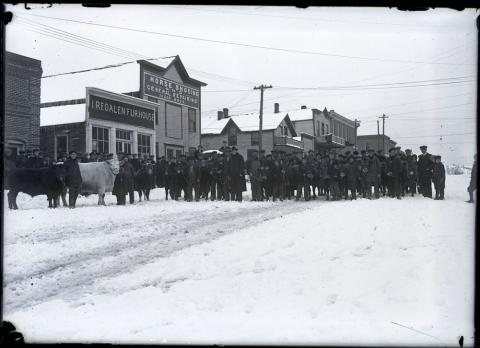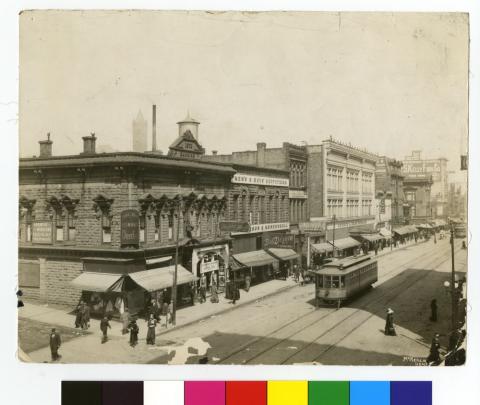Primary Source Set
by Grace Onsrud, Minnesota Digital Library Volunteer
Architecture Business and Industry Transportation
A main street is a part of the central business district of a city or town that has retail stores, banks, and other businesses that draw people to the area for work or leisure. Minnesota’s main streets have weathered many changes alongside changes in transportation technology, industry, and town needs. Towns that formed their main street along a railroad are now more likely to face a highway. Main streets built for horses and carts adapted to new forms of transportation such as streetcar systems, cars and buses. One primary source from 1916 shows construction of streetcar tracks on Chicago Avenue in Minneapolis, and a later source shows workers removing them from the Broadway Avenue Bridge in 1951. Stillwater began as a lumber town, with a main street filled with grocery stores, hardware stores, and other businesses that supported locally-based industry. As the lumbering died out, the main street filled with antique shops catering more to visitors than residents.
Changing ideas about the purpose and value of main streets have had real-life impacts on the way these streets look and function. Should the main street be like a highway, designed to transport you from one place to another as efficiently as possible? Or is it a place for pedestrians to wander and window-shop? Should it support small businesses or large chains? Is it a place for work or for leisure and entertainment? The images in this set capture views of some of the same main streets in different historical periods, serving different purposes. Photographs show St. Germain Street in St. Cloud lined with businesses and horse-drawn vehicles in 1907, with cars and paved roads in 1949, and under construction in 1972 as it was converted to a pedestrian mall. The street has since opened up to cars again.
Larger towns and cities often have more than one main street. Individual neighborhoods within cities have different areas where businesses cluster. Which main streets a city prioritizes has historically depended on the race or class of the people who have businesses and homes there. Rondo Avenue was a busy main street in a St. Paul neighborhood that was once home to eighty percent of St. Paul’s Black population. Rondo Avenue, along with much of the rest of the neighborhood, was demolished with the construction of I-94 in the 1950s-1960s. The community continues to commemorate Rondo with an annual festival, and there are efforts to repair the area by building a land bridge across the highway.
The meaning of main streets remain up for interpretation today as the way Minnesotans shop, work, and socialize continues to change. It is clear that whatever form a main street takes, it has a deep impact on community identity in cities and towns.
Discussion Questions & Activities
- The primary sources in this set show main streets in Minnesota from 1875 to 1988. Why do many towns and city neighborhoods have main streets? Why are they important?
- What are some important elements of a main street? What qualities would your ideal main street have?
- How do main streets function differently in small towns versus larger cities? Do you see any evidence of these differences in the primary sources?
- What similarities and differences do you notice in streets shown in different time periods? What kinds of businesses do you see along the streets at different times?
- Why do main streets change over time?
eLibrary Minnesota Resources (for Minnesota residents)
Chin, Richard. "TV show says "Good Morning" to Stillwater." (Page E6). Star Tribune (1987-), Jul 07, 2023. ProQuest. Accessed April 20, 2024.
Galioto, Katie. "What's in a name for Rondo?" (Page B1). Star Tribune (1987-), Dec 10, 2023. ProQuest. Accessed April 27, 2024.
"Mass transit." Britannica School, Encyclopædia Britannica, 30 Jul. 2021. Accessed 10 Oct. 2025.
Peterson, Brent T. Stillwater. Charleston, SC: Arcadia Publishing, 2013. Mackinvia. Accessed April 29, 2024.
"Urban planning." Britannica School, Encyclopædia Britannica, 4 Apr. 2018. Accessed 10 Oct. 2025.
"Urban Planning." Gale In Context Online Collection, Gale, 2022. Gale In Context: High School. Accessed 10 Oct. 2025.
Additional Resources for Research
Atkins, Annette. "St. Paul, Minneapolis, and Minnesota's Urban Origins." MNopedia, Minnesota Historical Society. Accessed April 13, 2024.
"Black History and its Influence on the East 38th St Community." Ward 8 Historical Walking Tour, Minneapolis City of Lakes. Accessed April 20, 2024.
Cameron, Linda A.. "Horsecars of the St. Paul and Minneapolis Street Railway Companies." MNopedia, Minnesota Historical Society. Accessed April 13, 2024.
Cameron, Linda A.. "Twin City Rapid Transit Company and Electric Streetcars." MNopedia, Minnesota Historical Society. Accessed April 13, 2024.
Colbert Jr., Harry. "West Broadway." Minneapolis Cultural Districts. Accessed April 27, 2024.
"History." Reconnect Rondo. Accessed April 30, 2024.
Mendez, Natalia. "East Lake Street." Minneapolis Cultural Districts. Accessed April 27, 2024.
National Register of Historic Places Registration Form: St. Cloud Commercial Historic District. NPS Form 10-900 (Oct 1990). United States Department of the Interior- National Park Service.
Orvell, Miles. "A Short History of the Idea of 'Main Street' in America." What it Means to Be an American, Smithsonian and Arizona State University, Oct. 16, 2017. Accessed April 20, 2024
Sturdevant, Andy. "Seeking downtown Bloomington — whose Main Street is called 494." MinnPost, Mar 24, 2016. Accessed April 20, 2024.
"Up the incline from Superior Street, Duluth, Minn." Detroit Publishing Co., 1908. Photograph. Library of Congress.
Published onLast Updated on























